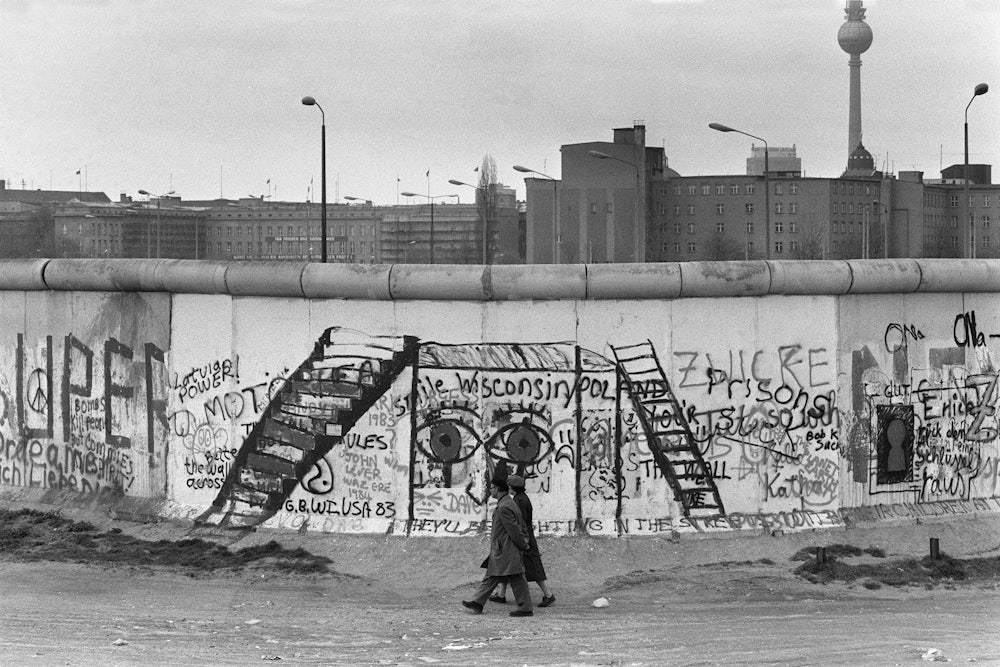Deborah Levy’s The Man Who Saw Everything begins with a subtle instant of subversion. It is September 1988 and a 28-year-old man named Saul Adler has come to London’s Abbey Road to have his photo taken at the zebra crossing where the Beatles posed for their iconic album cover. The site has been a tourist destination for years. Saul, however, is no tourist; he is a British academic, preparing to travel to East Berlin. The photograph, to be taken by his girlfriend Jennifer Moreau, is meant for his German host’s younger sister, a maniacal fan. Yet before Jennifer’s arrival, Saul is struck in the crosswalk by a car. “You walked on to the crossing and I slowed down, preparing to stop, but then you changed your mind and walked back to the kerb,” the shaken driver tells him. “And then without warning you lurched forward on to the crossing.”

On the one hand, this is a pointed piece of misdirection, what Saul identifies as a “careful reconstruction of history, blatantly told in his favour.” On the other, it’s a clue or a harbinger—that in the universe of Levy’s novel, nothing will be as it appears. Even the setting, so recognizable it’s become a piece of our collective pop cultural unconscious, is deceptive, a source of countless (re-)assembled memories. Just do a search and you can see it, that image from the record, juxtaposed against recreation after recreation: four Japanese tourists, two men in Beatle suits, a musician performing a handstand, a woman in a walking cast. It is a scene both framed by and unmoored from its historical moment, which like all historical moments has been absorbed into the past.
This question of history, or more accurately its fluidity, is central to Levy’s novel, which begins not only in the shadow of Abbey Road but also that of the Berlin Wall. “Germany East and West will be one,” Saul later predicts to his East German host, a translator named Walter. “There will be a revolution. With the exception of Romania there will be no blood shed on the streets.” That we, from the perspective of our moment, know this to be true is paradoxically part of the prognostication’s power. It’s as if Levy is reminding us that fiction, not unlike history, exists on a continuum, in which a variety of eras, beginning with the one in which the book takes place and extending to the one in which we read it, can co-exist at once. What happens when these epochs begin to talk to each other, or better yet, to overlap? “I’ve mixed then and now all up,” Saul laments. He’s describing how it feels to come unstuck in time.
Time travel, of course, is part of nearly every narrative experience, if only because storytelling is so often a retrospective act. We have to live it, or imagine it, before we can recreate it; this is how authority takes shape. All the same, I want to push back on this a little, especially in regard to naturalistic fiction, which The Man Who Saw Everything is and is not. Yes, Levy’s novel unfolds in a specific time and place with clear historical parameters. But she also undercuts the idea of plot (or at least its inevitability) by rendering Saul as self-absorbed and newly brittle, as if he had emerged from his accident in an alternate frame of mind.
“I began to speak,” he tells us, after arriving in Berlin. “I heard myself say things I did not know I thought. I told Walter that what really worried me on Abbey Road was that my mother had died in a car crash when I was twelve. … I told him that my mother’s fatal accident and my minor accident had become blurred in my mind and how I was still insatiably angry with the driver who had run her over.” That we have not heard any of this before now is the point.
What Levy is suggesting is that time is a construct, that it takes a disruption—an accident or a revolution—to stir us to consciousness. Saul is a vivid vehicle because he is not particularly sympathetic: beautiful, with a rock star haircut and an eye that wanders, he takes everything (his life, his past, his relationship with Jennifer) for granted, until his complacency is pierced. The Man Who Saw Everything, then, offers a narrative of awakening, in which Saul, in his way, is reborn as an innocent, a naïf tracing and retracing his steps, his memories, through an elusive world.
As for how this develops, it has to do with the way Levy builds the book. First, there is the blurring between inner and outer, between Saul’s post-accident confusion and the who, what, when, where, how of communism’s fall. For Saul, both narratives are personal: His long-dead father was a communist, and Saul carries a matchbox of his ashes to bury in East German soil. Such a tension has its playful aspects; the older man keeps returning, ghost or figment of the imagination, throughout the book. At the same time, the drift, the disconnect, of her narrator enables Levy to open up the novel, not just through the chronology, but also through an increasing attention to sequences and signs.
Take Abbey Road, where the novel begins, and then begins again 28 years later, in an audacious act of echoing. That number is important: If Saul is 28 in the opening pages, he is twice that when he returns to the scene and suffers another accident. Or does he? The second half of the novel, which takes place largely in his imagination as he convalesces, casts into doubt the verifiability of pretty much everything. Here, we see Levy at her most associative, in regard both to Saul’s increasingly non-linear experience and also to the physical world.
The zebra crosswalk is a case-in-point, legendary because of a photo that is more enigmatic than it appears. For decades, Beatles obsessives have cited the order of the musicians—John, in white as an angel; Ringo, in his black suit as the preacher; Paul, barefoot and out of step as the cadaver; George, in denim as the gravedigger—to support the myth that Paul was dead. In the background, a VW bug bears the license plate 28 IF—a reference to his age if he had lived. That Saul is also 28 when we meet him can hardly be coincidence. Then, there’s this: Two thousand years ago, another Saul reinvented himself as Paul after his conversion on a different road, the Road to Damascus: a mystical experience that left him “three days without sight.”
I don’t mean to suggest that Levy intends The Man Who Saw Everything as a parable—although all narratives, I’d argue, are parables in their way. Regardless, the issues she’s addressing are the big ones: identity, intimacy, inheritance, the search for meaning, the balance (or imbalance) of private and public life. Saul is a cipher, a chimera; even before the accident(s), he is unsure of what he wants. He sleeps with Walter and then with Walter’s sister; he fathers at least one child, and possibly a second, only to end up, through one set of betrayals or another, effectively abandoning both. That we learn this not as it happens but after the fact, as it is recollected, is among the most compelling aspects of the novel, especially given Saul’s unreliability.
“It was true,” he exclaims, “that my wings were wounded. It was true that I had no idea how to endure being alive and everything that comes with it. Responsibility. Love. Death. Sex. Loneliness. History.” The statement reveals a narrator who does not, in the most essential sense, know himself. This renders The Man Who Saw Everything less a journey of discovery, a bildungsroman, than its opposite: a saga of unraveling. And that, in turn, gives the book an understated power, as we confront a writer working against expectation to subvert the conventions of the novel, to rethink the form on her own terms.
What this requires is a kind of openness, or more precisely a willingness not to know. I don’t know, for instance, whether the novel works, completely; it is inconsistent, although how could that not be the case, with Saul as narrator? More to the point, the inconsistency points to a deeper layer of consistency—not just with Saul but also with the characters in Levy’s Man Booker-shortlisted novel Swimming Home, which involved a different sort of blurring, and the fragmented self-portraits in her “working autobiographies” Things I Don’t Want to Know and The Cost of Living. Those memoirs track a life in pieces, trying to move toward meaning, while acknowledging that meaning is a destination we never fully reach.
“What would it cost to step out of character and stop the story?” Levy asks in The Cost of Living, and the question resonates throughout The Man Who Saw Everything as well. Resolution, in other words, is less important than exploration. It’s the questions, not the answers, that bring us most acutely to life. Or, as Saul reflects: “Who were you? What languages do you speak? Are you a son and a brother and a father? Are you an acquisition? … Are you curious about other people? Or do you walk on the outer edges of life, indifferent, remote, tormented by the affection human beings seem to feel for each other? … Are you loving? Have you ever been loved?”
